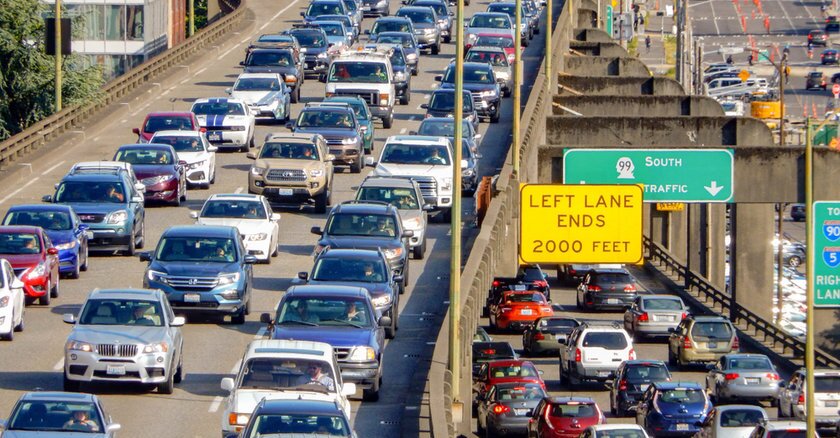What if the national recovery maintained some of these unexpected environmental gains?
“What we saw during stay-home-orders were a lot of our customers were reaching out to us and saying, ‘we’re seeing a huge drop in VMT [vehicle miles traveled],’” said Phaedra Hise, director of content marketing at StreetLight Data. “A lot of our constituents and residents are excited about the environmental benefits of that — though clearly not the economic effects.”
Hise is also the author of Streetlight Data’s Transportation Climate Impact Index, which ranks the 100 largest metro regions on six significant per capita categories to get a sense of how those networks contribute to climate-warming greenhouse gases.
Since the January release of that ranking index, the transportation analytics firm has since released another report examining the significant reduction in vehicular activity in the 100 largest U.S. metros. That report zeros in on how tinkering with transportation policy directions could continue to yield drops in vehicle activity.
The idea behind the most recent study was to examine the effects of different policy directions in different cities to “make a meaningful difference in VMT in each city in a different way, and how that could change their ranking,” Hise said.
The study focused on four cities to see how simply focusing on a single factor such as maintaining significant work-from-home patterns might move the VMT needle.
“We used the same factors and the same methodology for the original lists and just sort of examined what they would look like if they were able to make some significant changes,” said Hise.
In Seattle, StreetLight Data researchers concluded 19 percent of vehicle miles traveled in the region is related to commuter activity.
“That’s a significant number, and we could reduce that by one-fifth, or two-fifths. People stay home one day a week or two days a week, that starts getting us close to a 5 percent decrease in Seattle’s VMT. So that’s a really meaningful step in that direction,” Hise said.
Despite the introduction of more fuel-efficient vehicles, and the fractional adoption of electric cars, transportation remains a powerful contributor to planet-warming gases, generally acounting for about 40 percent of the greenhouse gas pie.
A study by the Brookings Metropolitan Policy Program found VMT increased in the United States about 10 percent from January 2015 to January 2020, before dropping precipitously during the nationwide shutdowns related to the pandemic.
In Seattle, shelter-in-place orders translated to a 71 percent drop in VMT, according to StreetLight Data. Traffic in Los Angles and Atlanta declined 72 percent, while Denver fell 73 percent.
Too often, said Susan Shaheen, director of resilient and innovative mobility at the University of California Institute of Transportation Studies, a region’s economic health is tied to traffic. Wholesale societal shifts such as the rise of remote working, telemedicine and other related policies could lead to reducing VMT and “decoupling” the marriage between economic activity and traffic.
“Cities should be looking at enablers for digital infrastructure that could encourage telework, distance learning, and remote access,” said Shaheen in an email. “Enabling and encouraging telework, for instance, by the public and private sectors is an immediate and potentially effective policy strategy for reducing VMT, while mitigating economic impacts.”
Cities, Hise said, were asking for “guidance” regarding “what kinds of studies should we be doing right now to learn more about this? What can we do to reap the benefits of this as we begin to recover?”
“We took those questions back and started asking, ‘How can our metrics help inform these goals, and these desires?’” she added.
In Denver, where a number of streets were closed to car traffic during the pandemic, the study explored how transitioning some streets to uses other than vehicular traffic could reduce VMT.
“If cities want to close more roads to personal vehicles, we can provide the metrics for them to analyze which roads should be closed and what impact that could potentially have,” Hise said.
StreetLight Data also released an easy-to-use widget, where each of the 100 metros can be re-ranked in the Climate Impact Report based on how significantly they are able to dial back VMT.















